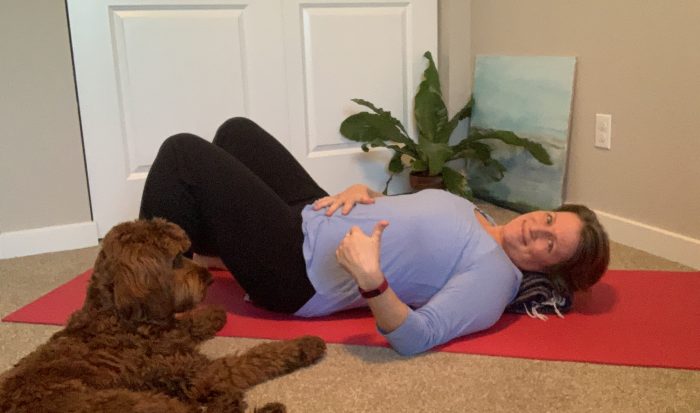Celebrate International Yoga Day: Just Lie Down.
“Enjoy your Savasana. Be respectful of others when you leave!”
Yikes!
I would venture to say all the ancient yogis turn in their graves when a yoga teacher walks out at the end of class and tells the participants this.
The job of a yoga teacher is to hold space for the experience of others. That means that the resting offered at the end of a yoga practice is the integration, the healing, the coming together of all the ingredients of a yoga practice.
Think of it as a stew. When my hubby makes his delicious chili or shrimp creole, I know it will be richer, spicier, and all-around more delish the next day. After resting in the fridge. Rest = the magic.
(Don’t skip the resting part!)
I sometimes joke while teaching class by telling everyone, “If today’s yoga is just lying on your back and snoring quietly, then so be it. That is your yoga today!” Everyone laughs, but I am serious.
Americans (or maybe more than just Americans) are so goal-oriented, so product-driven—everything has to be “Insta worthy.” The idea of just lying down and resting is the antithesis of our culture. I get it; I feel it sometimes, too—the need to get going.
So, I offer this:
>> Take it slow.
>> Maybe set a timer for five minutes to just lie there.
>> Sit quietly.
>> Find a resting shape that feels safe and whole for you after a movement practice.
>> Feel your breath.
Stress to muscles, tendons, bones, and ligaments without adequate recovery is not sustainable.
Eventually, stress leads to injury, maybe in the short-term with pain or the long-term with degeneration. Without rest, the body cells see the stress event as a catastrophic accident and go into survival mode, not experiencing integration and recovery. Our million-year-old nervous system wasn’t designed for constant, chronic stress, so this means we carry low-grade inflammation in the body all the time, whether you eat vegan and do yoga or couch-potato it out with a burger and fries.
So, at the end of any muscle stress, the experts say a 1-3 minute resting time is optimal before doing the other side or moving on to another stretch. It seems counterintuitive as we are “in the groove” to stop and rest, but not only is this short rest good for our muscular system, it serves a purpose for our nervous system as well. Say you just did a Vinyasa flow, rising to Sun Salutations, and your muscles and heart are humming away. That intensity gives the wandering monkey mind a place to focus. With endorphin neurochemicals releasing, acting on the same part of the body as opioids like morphine, we feel so good.
If we are living in “stress mode” all day, every day, this feels really good—a high. But while it is soothing, it doesn’t heal. Anxiety is just hiding under a layer of happy chemicals. As tough as it is to slow down, it may be the best thing for us.
After movement that stresses joints, tissues, and muscles, we can take a mindful body scan in a restful shape: standing with knees soft and lifted spine, child’s pose, an easy seated pose, or Savasana. Doing a quick body scan, letting the mind’s attention focus lightly from toes to the crown of the head, scanning the body without judgement or storyline allows the healing to go deeper. The nervous system’s survival mode begins to release, and true healing can happen.
In that space, feelings may come up, and that can feel a little scary. We don’t like the perceived chaos of “feelings.” There might be shaking, tears welling up, a sense of fear, worry, irritation, or anger. And God forbid this happens in public.
But the thing is, focusing on our Vinyasa flow and energizing the heart primes the healing pump, so to speak. We just have to see it through, no judgement, no stories or justification or victimizing ourselves. Our systems know how to bring healing deeper. We just have to allow it the space to happen.
So, maybe our nervous system is ready to release some stuff—it may be deeply buried stuff. It may not.
Feelings may flow through us; we can breathe them gently on their way, noting how they feel physically, with curiosity and a bit of compassion. The magic is that when we trust our bodies, brains, and hearts to do that voodoo that we do best, energy moves through us the way it is intended to move. Neuroscientists say that the life span of a feeling is 90 seconds. Our minds—the creation of a story around it—cause that feeling to sink into us and last for days, weeks, or years.
So, we can be a little vulnerable during a Savasana, creating the optimal situation for body and heart healing, or we can stuff those pesky feelings down and they will express themselves with pain in the joints, digestion trouble, and a tough time sleeping. We will think, “WTF? I do yoga. Why am I not sleeping well?”
Rest is the key.
Some yoga teachers do guided meditations during Savasana, some teachers turn off the lights and leave the room, some do a 30-second lying down at the end of a practice and talk the whole time, and some Savasanas stretch to 15-20 minutes. Classes may take mindful, short rests along the way. Some practices (like Yoga Nidra) are designed to bring deep rest the whole session. So, what’s a body to do?
Any way you like it.
While you are in class, you follow whatever the teacher does, but if that teacher does not encourage rest and recovery, do it on your own after the practice (or find another teacher). Seriously, it is that important. Although, hopefully, if you approach the teacher with a desire for a long, quiet rest, the teacher will hear your needs.
Rest doesn’t need to look one way. You can rest standing with your feet more than shoulder-width apart, your knees soft, and your arms gently in a loose circle in front of you. This is tree pose in Qi Gong. Loosening your body and relaxing in this shape at the end of a practice can bring great energy throughout your entire system. Savasana can happen seated as well: easy seated pose or full lotus if that’s your jam. Stillness isn’t required either. If you like resting on your tummy with legs bent and swinging side to side windshield wiper style, go for it!
Rest your mind, soften your gaze, and soften into mindful, focused breathing for 3-5 minutes. Traditional Savasana is flat on the floor with palms and soles of your feet facing up, but you can adjust that too. Maybe turn to one side, knees bent, and a pillow, blanket, or block between your legs to rest your low back. Rest, and breathe. That’s it!
Gimme a sweet cinnamon-bun-Savasana any day.
I learned this in a yin yoga teacher training, and it is my hubby’s favorite way to rest. If you have a thick Mexican-style blanket, that works best, but any blanket that has some heft will work. Fold the blanket in half along the shorter side—hamburger bun style. Then, hold the folded side and fold back and forth like you are making a paper fan, keeping your blanket folds about 3-4 inches wide, ending with the fringe edge.
Lay the folded blanket in the center of your mat, with the end of the folded blanket right at your tailbone. The blanket will extend up past your head. (This is the cinnamon bun part!) Lay your spine down on the center of the folded blanket, reach up and grab the end of your blanket and roll under, turning and turning until the roll is under your head and neck. Yum. You can put a bolster or cushion under your bent knees if you like.
Now rest here for 3-5 minutes. Or 20. Maybe even snoring quietly.



Read 11 comments and reply